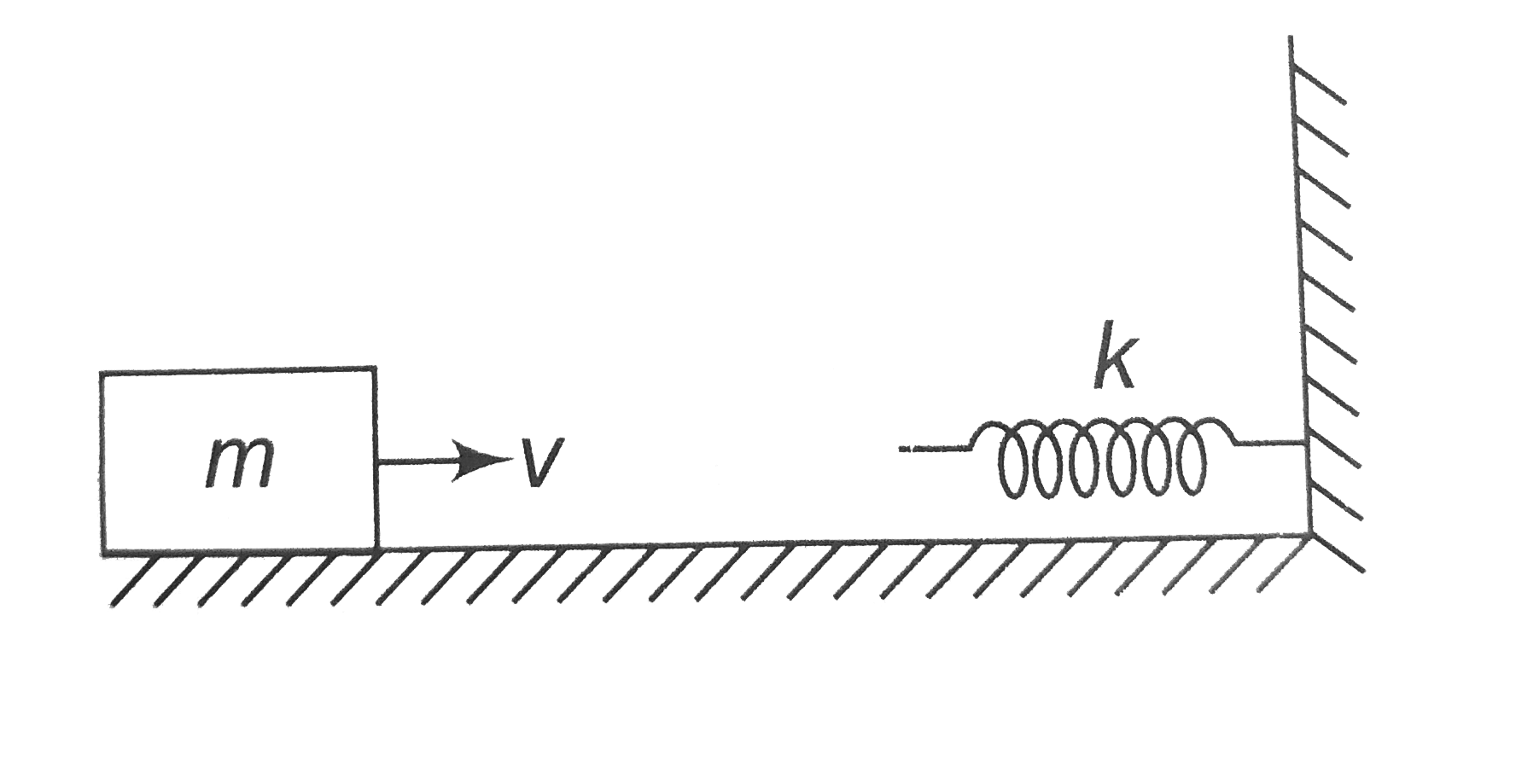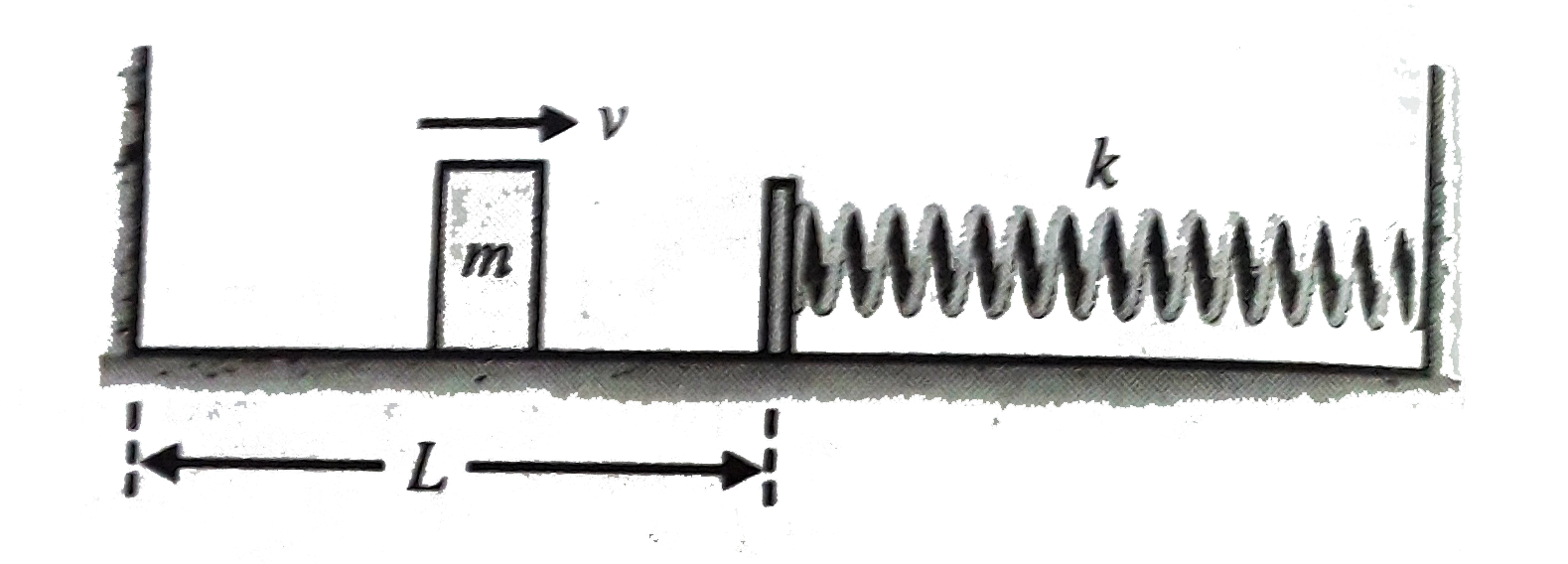A block of mass m moving at a speed v compresses a spring throgh a distance x before its speed is halved. Find the spring constant of the spring.
The correct Answer is:B, C, D
To solve the problem, we will use the principle of conservation of energy. The initial kinetic energy of the block will be converted into the kinetic energy of the block when its speed is halved and the potential energy stored in the spring when it is compressed.
1. Identify Initial and Final Energies:
- The initial kinetic energy (KE_initial) of the block when it is moving at speed v is given by:
KEinitial=12mv2
2. Determine Final Speed and Kinetic Energy:
- When the block compresses the spring by a distance x, its speed is halved. Thus, the final speed vf is:
vf=v2
- The final kinetic energy (KE_final) when the speed is halved is:
KEfinal=12m(v2)2=12mv24=18mv2
3. Calculate Potential Energy in the Spring:
- The potential energy (PE) stored in the spring when it is compressed by distance x is given by:
PE=12kx2
4. Apply Conservation of Energy:
- According to the conservation of energy, the initial kinetic energy is equal to the sum of the final kinetic energy and the potential energy stored in the spring:
KEinitial=KEfinal+PE
- Substituting the expressions we derived:
12mv2=18mv2+12kx2
5. Rearranging the Equation:
- To isolate the spring constant k, we rearrange the equation:
12mv2−18mv2=12kx2
- Finding a common denominator for the left side:
48mv2−18mv2=38mv2
- Thus, we have:
38mv2=12kx2
6. Solving for the Spring Constant k:
- Multiply both sides by 2 to eliminate the fraction:
34mv2=kx2
- Finally, solve for k:
k=3mv24x2
Final Answer:
The spring constant k is given by:
k=3mv24x2
- The initial kinetic energy (KE_initial) of the block when it is moving at speed v is given by:
KEinitial=12mv2
- When the block compresses the spring by a distance x, its speed is halved. Thus, the final speed vf is:
vf=v2
- The final kinetic energy (KE_final) when the speed is halved is:
KEfinal=12m(v2)2=12mv24=18mv2
- The potential energy (PE) stored in the spring when it is compressed by distance x is given by:
PE=12kx2
- According to the conservation of energy, the initial kinetic energy is equal to the sum of the final kinetic energy and the potential energy stored in the spring:
KEinitial=KEfinal+PE
- Substituting the expressions we derived:
12mv2=18mv2+12kx2
- To isolate the spring constant k, we rearrange the equation:
12mv2−18mv2=12kx2
- Finding a common denominator for the left side:
48mv2−18mv2=38mv2
- Thus, we have:
38mv2=12kx2
- Multiply both sides by 2 to eliminate the fraction:
34mv2=kx2
- Finally, solve for k:
k=3mv24x2
The spring constant k is given by:
k=3mv24x2
Topper's Solved these Questions
- WORK, ENERGY & POWERBOOK - DC PANDEYCHAPTER - WORK, ENERGY & POWEREXERCISE - Level 2 Comprehension Based
2 Videos
- WORK, ENERGY & POWERBOOK - DC PANDEYCHAPTER - WORK, ENERGY & POWEREXERCISE - Level 2 More Than One Correct
9 Videos
- WAVE MOTIONBOOK - DC PANDEYCHAPTER - WAVE MOTIONEXERCISE - Integer Type Question
11 Videos
- WORK, ENERGY AND POWERBOOK - DC PANDEYCHAPTER - WORK, ENERGY AND POWEREXERCISE - MEDICAL ENTRACES GALLERY
33 Videos
Similar Questions
A block of mass m moving at a speed v compresses as spring thrugh a distance x before its speed is halved. Find the spring constant of the spring.
View SolutionA block of mass m moving at a speed v compresses a spring through a distance x before its speed is halved. The spring constant of the spring is 6mv2nx2. Find value of n.
View Solution
Knowledge Check
A block of mass m is moving with a speed v on a horizontal rough surface and collides with a horizontal mounted spring of spring constant k as shown in the figure .The coefficient of friction between the block and the floor is μ The maximum compression of the spring is
 A−μmgk+1k√(μmg)2+mkv2Bμmgk+1k√(μmg)2+mkv2C−μmgk+1k√(μmg)2−mkv2Dμmgk+1k√(μmg)2+mkv2
A−μmgk+1k√(μmg)2+mkv2Bμmgk+1k√(μmg)2+mkv2C−μmgk+1k√(μmg)2−mkv2Dμmgk+1k√(μmg)2+mkv2A block of 200 g mass is dropped from a height of 2 m on to a spring and compress the spring to a distance of 50 cm. The force constant of the spring is
A20Nm−1B40Nm−1C30Nm−1D60Nm−1A block of mass m is pushed up against a spring, compressing it a distance x, and the block is then released. The spring projects the block along a frictionaless horizontal surface, grving the block a speed v. The same spring projects a second block of mass 4m, giving it a speed 3v. What distance was the spring compressed in the second case ?
A6xBx6C36xD12x
A block of mass m moving at a speed v0 compresses a spring of spring constant k as shown in the figure. Find (a) the maximum compression of spring and (b) speed of the block when the spring is compressed to half of maximum compression.
View SolutionBlock of mass m is pushed towards a horizontal spring as shown in figure , with initial speed u .

Spring constant of the spring is K and floor is smooth . Calculate maximum possible compression of the spring .
View SolutionA block of mass 2 kg is moving on a frictionless horizontal surface with a velocity of 1m/s towards another block of equal mass kept at rest. The spring constant of the spring fixed at one end is 100N/m. Find the rnaximum compression of the spring

View Solution
A spring having a spring constant k is fixed to a vertical wall as shown in Fig. A block of mass m moves with velocity v torards the spring from a parallel wall opposite to this wall. The mass hits the free end of the spring compressing it and is decelerated by the spring force and comes to rest and then turns the spring is decelerated by the spring force and comes to rest and then turns back till the spring acquires its natural length and contact with the spring is broken. In this process, it regains its angular speed in the opposite direction and makes a perfect elastice collision on the opposite left wall and starts moving with same speed as before towards right. The above processes are repeated and there is periodic oscillation.
Q. What is the time period of oscillation ?
View Solution
A spring having a spring constant k is fixed to a vertical wall as shown in Fig. A block of mass m moves with velocity v torards the spring from a parallel wall opposite to this wall. The mass hits the free end of the spring compressing it and is decelerated by the spring force and comes to rest and then turns the spring is decelerated by the spring force and comes to rest and then turns back till the spring acquires its natural length and contact with the spring is broken. In this process, it regains its angular speed in the opposite direction and makes a perfect elastice collision on the opposite left wall and starts moving with same speed as before towards right. The above processes are repeated and there is periodic oscillation.
Q. What is the maximum compression produced in the spring?
View Solution
